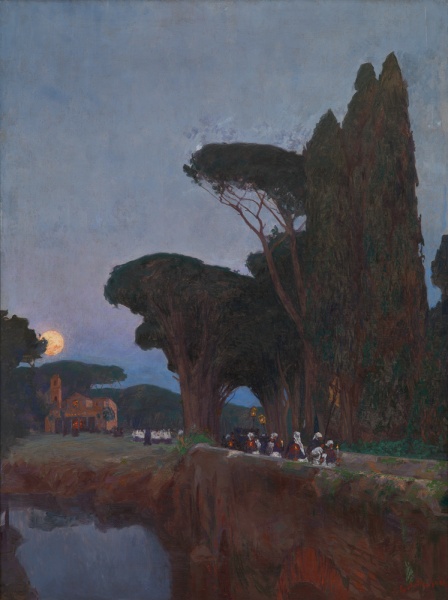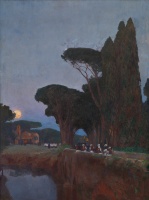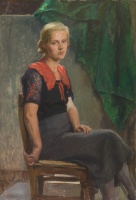

A Catholic Procession
| Author: |
Jehudo Epstein (1870–1945)  |
| Created: | 1901 |
| Material: | canvas |
| Technique: | oil |
| Dimensions: | 100 × 75 cm |
| Signature: | bottom right: J. Epstein / 1901 |
This picture, painted in the first years of the 20th century, reflects the feeling of that period: the scenery is presented in a mysterious space, with huge trees weltering in the moonlight. The symbolic composition proclaims the power of nature, eternity and the fragility of human life, and conveys a mystical mood. As a follower of Secessionism, Epstein accentuates the lush shapes of the trees, their spontaneous growth, and the flexible and sleek silhouettes of vegetation, and aims to achieve a symbolic mood unfolding in the evening twilight.
Text author Dalia Tarandaitė
Judaism and Christianity. Although Christianity has its roots in Judaism, there is a sharp divide between the two religions today. Judaism sees any faith as an effective tool; thus, for the Jews, a Christian church is more than just a building. It is a place where Christianity is tangible, and faith permeates the walls and space of the church. In the same way, Judaism sees its own faith as being manifested in the space of the synagogue. Therefore, since the Middle Ages, and especially after the growth of Christian art, according to the consensus of the rabbis, halakhah has forbidden Jews to visit the houses of prayer of other faiths, even just for the purpose of admiring the architecture or works of art, because a believer entering a church experiences the impact of Christianity. However subconscious this experience may be, it is incompatible with the Jewish faith and practice.
Yehudo Meier Epstein was deeply impressed by the Christian holidays that he witnessed in his childhood. Although the artist inherited from his father, a Talmudist and Hebrew teacher, a deep knowledge of Jewish scripture, and was well versed in halakhah, he could not resist the temptation to depict Catholic prayers in a church or a solemn procession with a cross, banners, lanterns, candles and hymns. Details of Christian culture also appear in the series of six small paintings ‘Lithuanian Folk Sculpture. Still-Lifes’ by Augustinas Savickas, created in the 1950s and 1960s. The religious theme here is represented by folk sculptures: the saints, figures of the Sorrowing Christ, the Crucified Christ, and the Pietà.
Text author Vilma Gradinskaitė
Source: Law firm Valiunas Ellex art album THE WORLD OF LANDSCAPES II (2013). Compiler and author Nijolė Tumėnienė, STORIES OF LITVAK ART (2023). Compiler and author Vilma GradinskaitėExpositions: “Académie de Vilna. Vilnius Drawing School (1866–1915)”, 5 October – 26 November 2017, National Gallery of Art, Vilnius (curator Jolanta Širkaitė). Published: Académie de Vilna: Vilniaus piešimo mokykla 1866-1915 / Vilnius drawing school: Exhibition Catalogue, Nacionalinė dailės galerija 2017 m. 4 d. - lapkričio 26 d., compiled by Jolanta Širkaitė, Vilnius: Lietuvos kultūros tyrimų institutas, 2017, p. 147.








